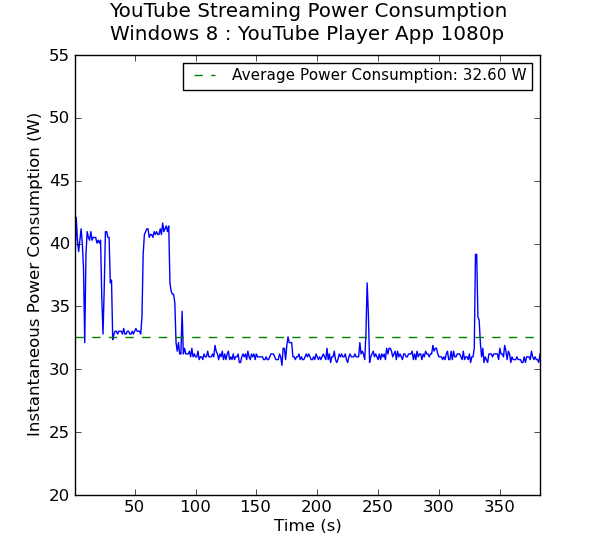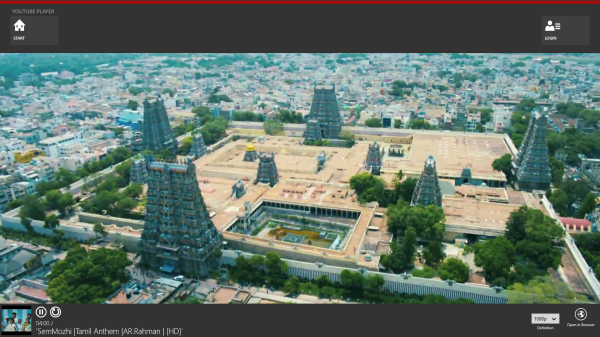Getting the Best out of an Ivy Bridge HTPC: Windows 8, madVR and More..
by Ganesh T S on January 20, 2013 3:00 PM EST- Posted in
- Home Theater
- Intel
- HTPC
- Ivy Bridge
- Windows 8
- Passive Cooling
Network Streaming Performance - YouTube
YouTube is one of the most popular video streaming services, and Google maintains a number of encodes for each stream. On platforms supporting Adobe Flash, FLV streams are available at resolutions ranging from 240p to 480p. HTML5 streams are either in WebM (for Firefox) or MP4 / H.264 (for Internet Explorer). WebM streams typically top out at 720p, while MP4 is the preferred format for 1080p. At higher resolutions, Adobe Flash also streams the MP4 version.
As expected, we get GPU acceleration when using Adobe Flash in Firefox on Windows 7. The debug OSD presents the requisite details.
HD YouTube Streaming using Adobe Flash in Mozilla Firefox on Windows 7
Windows 8 has an app for YouTube, 'YouTube Player' which allows for stream quality selection. Just like the Netflix app, there is no direct way to determine if GPU acceleration is being used.
HD YouTube Streaming using the YouTube Player App on Windows 8
We will rely on the power consumption at the wall to determine the efficiency of various ways to stream YouTube videos across different operating systems. Since the matrix of options is quite big, we present the graphs one at a time. All the graphs are on the same scale. Press the button below corresponding to the combination you want to compare the current graph against.

It can be seen that the Windows 8 YouTube Player App wins hands down. The stream being decoded is, in all probability, the 1080p H.264 version. Even when Adobe Flash is being used, Windows 8 seems to be more efficient compared to Windows 7. If you are on Windows, and prefer to use HTML5, it is better to avoid Mozilla Firefox because the WebM version consumes the most power at the wall (due to lack of hardware accelerated decode) while providing only a 720p stream. Once again, if YouTube forms a major part of your HTPC experience, an upgrade from Windows 7 to Windows 8 can be recommended.












138 Comments
View All Comments
HighTech4US - Sunday, January 20, 2013 - link
Agree, I see no other overall complete platform that would be better (or even equal) for a 4-OTA Tuner DVR with unlimited storage (only limited by disk size) with free EPG that Windows 7 Media Center provides.And by tricking out 7MC with MediaBrowser, MediaControl, SHARK007 Codecs I have a complete on demand system that can play any type of media.
I use MediaCenterMaster to get program meta information, backdrops and thumbnails for MediaBrowser.
I also use MakeMKV to rip my DVD's and VideoReDo TVSuite h.264 to edit recorded TV shows and convert them to H.264 MKV's.
Oh and 7MC can show your digital pictures as a slide show on your big screen with background music.
I also love the screen saver where it shows random pictures from your picture library then zooms to one (or more) from a folder. When I first got this enabled the wife spent 45 minutes just watching the screen saver.
powerarmour - Monday, January 21, 2013 - link
Agreed, WMC is only EPG based Tuner app that can correctly use Freeview HD DVB-T2 Tuners in the UK, there are no other usable HTPC alternatives.psuedonymous - Sunday, January 20, 2013 - link
Question: why was the obsolete 2-pass method used instead of the faster (and more common) CRF? Was the encoding benchmark intended as an artificial CPU-stressing benchmark rather than a 'real world' encoding benchmark?ganeshts - Sunday, January 20, 2013 - link
Hmm.. that is what Graysky's benchmark does, and it keeps the setting consistent across different systems when you want to see how much better or worse your system is, when compared to someone else's.FWIW, pass 1 stresses the memory subsystem, while pass 2 stresses the CPU.
ganeshts - Sunday, January 20, 2013 - link
Thanks for the info. I was looking at the FAQ hosted by TechARP here: http://www.techarp.com/showarticle.aspx?artno=442&... ;Also, look at Ian's test with various memory speeds here using the same processor (last section on this page):
http://www.anandtech.com/show/6372/memory-performa...
There is definitely an impact on pass 1 performance using different memory speeds and the impact is more than on pass 2.
Iketh - Sunday, January 20, 2013 - link
Why is Prime95 v25.9 used? That is grossly outdated. The latest official 27.7 is needed to tax Ivy Bridge with AVX instructions. All those temps and watts you got will increase significantly. Please revise your Prime95. An oversight like this is unacceptable.Not to mention the latest Intel compilers have been implementing AVX instructions for like 6+ months now even if the programmer didn't specifically write for it. AND Handbrake has been using AVX in about that same timeframe and is only increasing.....
ganeshts - Sunday, January 20, 2013 - link
I will definitely do some experiments with the new Prime95 and report back.ganeshts - Monday, January 21, 2013 - link
I repeated the CPU loading with the latest Prime95 (v27.7):http://i.imgur.com/lK0zqjR.png
The readings didn't go up significantly, but, yes, there is an increase. The power consumption at the wall increased from 58.25 to 62.56 W.
Thanks for bringing this to our attention, and we will make sure future reviews use the updated Prime95.
ganeshts - Monday, January 21, 2013 - link
Oh, but, with full GPU and CPU loading (using Furmark 1.10.3 - latest), the power at the wall is only 89.77 W (compared to 88.75 W earlier). The ~40 W / ~15W TDP distribution between the CPU and the GPU still remains the same.http://i.imgur.com/soCGAyk.jpg
I don't expect the steady state temperatures to be that different because the power increase at the wall is only 1 W.
ganeshts - Sunday, January 20, 2013 - link
Yes, the scaling algorithms affect the performance a lot.That is why I mentioned that we used the default settings: Bicubic with sharpness 75 for chroma (no anti-ringing filter), Lanczos 3-tap for image upscaling / Catmull-Rom for image downscaling (no anti-ringing filter or linear light scaling),
We will look at other scaling algorithms and their performance on the HD 4000 / GT 640 / AMD 7750 in the third part of the HTPC series.
Also, a note that if you are using HD 4000 (or any other Intel HD Graphics), I would strongly suggest looking at DXVA Scaling. Users might be surprised at the quality delivered without taxing the GPU too much.